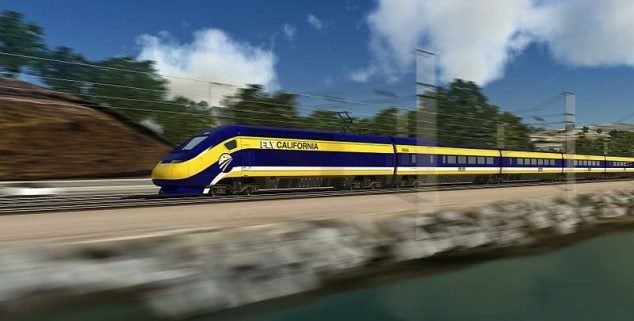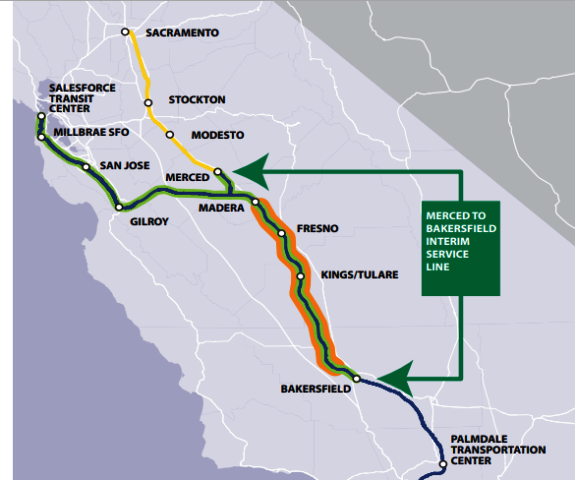News
CA bullet train hopeful over Biden’s infrastructure plan
 An artist's rendering of California's bullet train. (Image: High-Speed Rail Authority)
An artist's rendering of California's bullet train. (Image: High-Speed Rail Authority)State rail officials are taking the glass-half-full view. Rather than lamenting the fact that high speed rail is absent from the president’s infrastructure plan, they’re pointing to supportive statements from Biden and his team, and insisting there’s time before Congress irons out a final deal to claim a share for California’s fast train.
“It’s a lot of money,” Brian Annis, the High Speed Rail Authority’s chief financial officer, said of rail’s piece of the $2.3 trillion plan. “We’re talking $80 billion with a ‘b,’ and I can’t say we know how big our slice is going to be.”
Overall, said Annis, “We’re very pleased with it.”
“Talking about high speed rail, that’s infrastructure.” — President Biden
Unfortunately, when the president’s team laid out the pieces, California HSR’s sections appear to have been left of the box. Instead, Biden and his team are proposing $80 billion “to address Amtrak’s repair backlog; modernize the high traffic Northeast Corridor; improve existing corridors and connect new city pairs; and enhance the grant loan programs that support passenger and freight rail safety, efficiency and electrification.”
In the same summary, the White House notes “there are currently projects just waiting to be funded that will give millions more Americans reliable and fast inter-city train service.” It’s just high-speed rail isn’t mentioned among them.
Annis recalls optimistically the Obama Administration’s stimulus plan for the economy in the wake of the Great Recession. That was 2009, and California reaped $8 billion for the train project. Another $3.5 billion came the following year. Since then, however, the federal flow has halted.
So, taken in context, it’s not unreasonable to hope, even for a sliver of such a big pie. “With an $80-billion rail pot,” said Annis, “we’re happy with the total program.”
They take hope, too, from the president’s own words.
Talking with reporters outdoors on the Rachel Maddow Show on Monday, a masked President Biden offered examples of what he meant by infrastructure investment. Getting lead pipes out of schools, he said, was infrastructure, as was repairing aging federal buildings that are “absolutely leaking energy every single day.”
“Talking about high speed rail,” the president said, “that’s infrastructure.”
“There really is no doubt there is money in there for high-speed rail. The enormity of the pot should not be overlooked.” — Brian Annis
And state officials are happily sharing a portion of the president’s press remarks when rolling out the massive plan. On that day, President Biden said, “… Imagine what we can do, what’s within our reach if we modernize those highways. You and your family could travel coast to coast without a single tank of gas, on board a high-speed train.”
So, yes, he mentioned the concept of high speed rail, but only the concept, and only in an east-west direction, not the north-south alignment California needs.
“But,” Annis insists, “there really is no doubt there is money in there for high-speed rail. The enormity of the pot should not be overlooked.”
“Enormous barely covers it.”
The $2.3-trillion American Jobs Plan includes a whopping $621 billion on the broad category of transportation. But rail does not rank first, second or even third. The biggest slice, at $174 billion, goes to electric cars. The next biggest, at $115 billion, is for “modernizing” the nation’s roads and bridges. There’s $85 billion to invest in public transit, and then the number at issue, $80 billion, “for Amtrak and freight rail.”

A map of a portion of the high-speed rail lines. (Illustration: High Speed Rail Authority, 2021.)
In California, a 119-mile stretch of high-speed rail is under construction in the Central Valley, part of the planned link between Bakersfield and Merced. Ultimately, the California bullet train is envisioned as connecting the Bay Area-Sacramento region with Los Angeles and San Diego along 520 miles of track. Cost projections vary, but by one estimate the price tag for the total project is $80 billion. A California congressman, Jim Costa, D-Freson, has reintroduced legislation to finance $32 billion worth of projects in high-speed rail corridors.
Even if there isn’t a sweet plum for California’s promised railway in the big plan, a longer term question is whether the state can reestablish a steady stream of federal funds that will keep on coming.
“Definitely we’ve suffered in not having a federal funding partnership since 2010,” said Annis. “You need that kind of commitment. No doubt if we get a significant and sustained federal funding partnership, you could say that would be a game-changer going forward.”
Want to see more stories like this? Sign up for The Roundup, the free daily newsletter about California politics from the editors of Capitol Weekly. Stay up to date on the news you need to know.
Sign up below, then look for a confirmation email in your inbox.

Leave a Reply